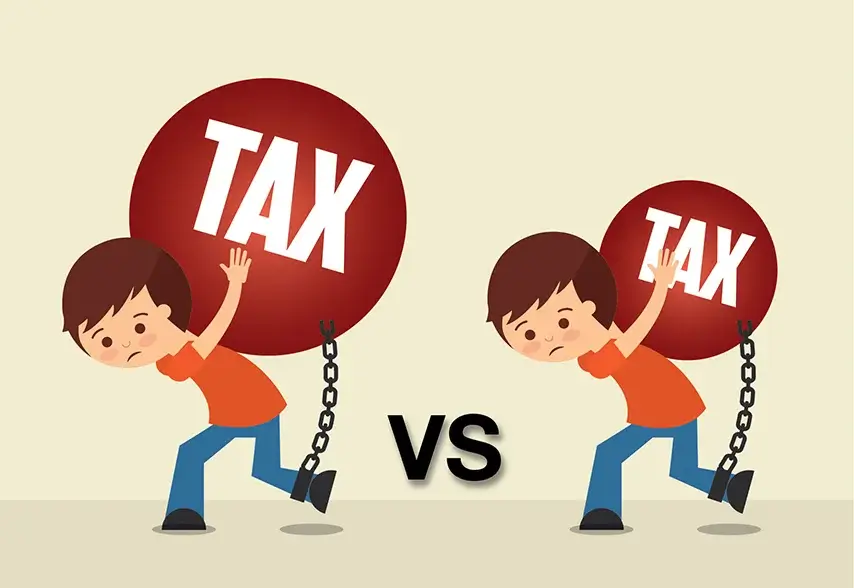Tax liability is the amount of tax to-be paid by the income earning individual/business to the government during a financial year. According to the Income Tax Act, the government levies the applicable taxes based on the profits or source of income of the individual/business.
Note that the Act is changed from time to time by the government, hence the tax brackets or tax slab are revised. The tax slabs comprise of different tax rates applied to different incomes levels.
Old Tax Regime vs New Tax Regime
Union Budget 2020-21 offers taxpayers a choice to either pay tax under the new regime by foregoing the tax exemptions/deductions they have been enjoying OR continue to pay tax under the existing income tax rates by claiming the exemptions and deductions (for example, 80C, 80D, HRA, LTA, and so on) that are applicable.
Note, however, that the choice of which regime to choose will vary basis the income slabs.
However, it’s also important to know that basic calculations show that if you are a salaried individual who claims a large number of exemptions and deductions (for example, 80C, 80D, interest on housing loan, HRA, LTA, special allowance, and so on), you are likely to be better off in the existing income tax regime.
Tax Rates Comparison:
| Old Regime Tax Rates | Annual Income | New Regime Tax Rates |
|---|---|---|
|
Nil |
Up to ₹ 2.5 lakhs |
Nil |
|
5% |
₹ 2.5 – 5 lakhs ₹ 5 – 7.5 lakhs |
5% 10% |
|
20% |
₹ 7.5 – 10 lakhs ₹ 10 – 12.5 lakhs |
15% 20% |
|
30% |
₹ 12.5 – 15 lakhs ₹ 15 lakhs and above |
25% 30% |
For your better understanding, here's an example showing the tax liability with and without exemption under both old and new tax regime:
| OLD TAX REGIME | NEW TAX REGIME | |
|---|---|---|
|
₹12.5 LAKHS |
ANNUAL INCOME |
₹12.5 LAKHS |
|
₹12.5 LAKHS |
TAXABLE INCOME |
₹12.5 LAKHS |
|
₹1.95 LAKHS |
TAX LIABILITY |
₹1.30 LAKHS |
|
₹12.5 LAKHS |
ANNUAL INCOME |
₹12.5 LAKHS |
|
-₹1,50,000 |
DEDUCTIONS U/S 80 (C) |
-- |
|
-₹50,000 |
DEDUCTIONS U/S 80 CCD (1B) |
-- |
|
-₹75,000* |
EXEMPTIONS U/S 80 (D) |
-- |
|
₹9.75 LAKHS |
TAXABLE INCOME |
₹12.5 LAKHS |
|
₹1.12 LAKHS |
TAX LIABILITY |
₹1.30 LAKHS |
* assuming for self and dependent parents being senior citizen ₹ 25,000 and ₹ 50,000 respectively.
Suggested Read: Old vs New Tax Regime – Which One Can Help You Save More Tax?
That’s Great! What are the Tax Saving Options u/s 80(C)?
In this tax season, let us reduce the tax burden using a number of legal methods that not only help in saving tax but also help in building a significant corpus for your and your family's future. As per the Indian Income Tax Act, Section 80(C) is the most-opted two tax-saving tool/scheme under which you can avail tax deductions up to a maximum amount of ₹1, 50,000.
Tax Deductions under Section 80(C)
The following is the list of all the financial instruments that are covered under Section 80(C):
- Investments in PPF (Public Provident Fund)
- Investments in EPF (Employee Provident Fund)
- Investments in ELSS funds (Equity-Linked Savings Scheme)
- Investments in NSC (National Savings Certificates)
- Payment of premiums against Life Insurance Policies
- Investments in ULIPs (Unit-Linked Insurance Plans)
- Investments in Tax-saving Fixed Deposits
- Investments in Senior Citizens Savings Scheme
- Investments in Sukanya Samriddhi Yojana
- Repayment of home loans
- Payment of children’s tuition fees
However, it is important to note that these tax deductions vary from one individual and/or business to the other. Hence, it is suggested to consult your tax consultant for the same.
Additionally, Future Generali India Life Insurance company offers a variety of insurance plans for varied tax benefits purposes. You can choose any of these plans that fits in your needs after consulting your tax consultant.
Suggested Read: 15 Smart Saving Options
To conclude, to save tax, investments under Section 80(C) are the best and most-opted choice! After all, there is no better investment that provides safety net to your family both in your presence and absence.



Comments
S
S